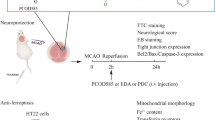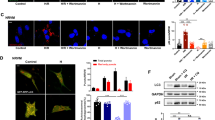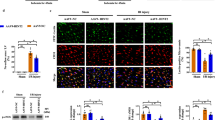Abstract
The aim of the present study was to investigate the mechanism of effect of 3-nitropropionic acid-(3-NP) induced late preconditioning in rat heart. For this purpose 20–30 min before 3-NP (20 mg/kg, i.p.) injection, the rats were treated intraperitoneally with 5-hydroxydecanoate (40 mg/kg, 5-HD, mitochondrial KATP-channel blocker), L-NAME (100 mg/kg, NOS inhibitor), N-2-mercaptopropionylglycine (100 mg/kg, MPG, free radical scavenger), or superoxide dismutase+catalase (10000+10000 IU/kg, SOD+CAT). Control rats received saline only without 3-NP pretreatment. After two days, hearts were isolated and perfused at a constant pressure in a Langendorff apparatus. 15-min global ischemia followed by 30-min reperfusion was applied to all hearts. Pretreatment of 3-NP significantly reduced infarct size, creatine kinase-MB (CK-MB), lactate dehydrogenase (LDH) levels, and incidence of ventricular tachycardia (VT) compared with the control group receiving saline only. 5-HD, L-NAME, MPG, or SOD+CAT treatment statistically reversed 3-NP-induced reduction in infarct size. Although CK-MB, LDH levels, and incidence of VT were also reduced by L-NAME, MPG, or SOD+CAT treatment, only 5-HD significantly inhibited beneficial effects of 3-NP on all of the parameters above. These results showed that mito-KATP channels play a pivotal role in late preconditioning effect of 3-NP in the isolated rat heart. However, other mediators such as reactive oxygen species and NO may be, at least in part, involved in mechanisms of this effect.
Similar content being viewed by others
References
Aketa, S., Nakase, H., Kamada, Y., Hiramitsu, K., and Sasaki, T., Chemical preconditioning with 3-nitropropionic acid in gerbil hippocampal slices: therapeutic window and the participation of adenosine receptor. Exp. Neurol., 166, 385–391 (2000).
Alkhulaifi, A. M., Yellon, D. M., and Pugsley, W. B., Preconditioning thr human heart during aorta-coronary bypass surgery. Eur. J. Cardio-thorac-Surg., 8, 270–276 (1994).
Altug, S., Demiryurek, A. T., Ak, D., Tuncel, M., and Kanzýk, I., Contribution of peroxynitrite to the beneficial effects of preconditioning on ischaemia-induced arrhythmias in rat isolated hearts. Eur. J. Pharmacol., 415, 239–246 (2001).
Altug, S., Demiryurek, A. T., Kane, K. A., and Kanzýk, I., Evidence for the involvement of peroxynitrite in ischaemic preconditioning in rat isolated hearts. Br. J. Pharmacol., 130, 125–131 (2000).
Bajgar, R., Seetharaman, S., Kowaltowski, A. J., Garlid, K. D., and Paucek, P., Identification and properties of a novel intracellular (mitochondrial) ATP-sensitive potassium channel in brain. J. Biol. Chem., 276, 33369–33374 (2001).
Basgut, B., Aypar-Mutlu, E., Akln, K. O., Klllc, N., and Caklcl, I., The late preconditioning effect of 3-nitropropionic acid in rat myocardium. Slovenska Kardiologija, 2,suppl.1, 40 (2005).
Bolli, R., Dawn, B., Tang, X. L., Qiu, Y., Ping, P., Xuan, Y. T., Jones, W. K., Takano, H., Guo, Y., and Zhang, J., The nitric oxide hypothesis of late preconditioning. Basic Res. Cardiol., 93, 325–338 (1998).
Borlongan, C. V., Koutousis, T. K., and Sanberg, P. R., 3-Nitropropionic acid animal model and Huntington’s disease. Neurosci. Biobehav. Rev., 3, 289–293 (1997).
Brambrink, A. M., Schneider, A., Noga, H., Astheimer, A., Gotz, B., Korner, I., Heimann, A., Welschof, M., and Kempski, O., Tolerance-Inducing dose of 3-nitropropionic acid modulates bcl-2 and bax balance in the rat brain: a potential mechanism of chemical preconditioning. J. Cereb. Blood Flow Metab., 20, 1425–1436 (2000).
Cave, A. C., Preconditioning induced protection against postischaemic contractile dysfunction: Characteristics and mechanisms. J. Mol. Cell. Cardiol., 27, 969–979 (1995).
Cribier, A., Korsatz, L., Koning, R., Rath, P., Gamra, H., Stix, G., Merchant, S., Chan, C., and Letac, B., Improved myocaardial ischemic response and enhanced collateral circulation with long repetitive coronary occllusion during angioplasty: a prospective study. J. Am. Coll. Cardiol., 20, 578–586 (1992).
Deutsch, E., Berger, M., Kussmaul, W. G., Hirshfeld, J. W., Hermann, H. C., and Laskey, W. K., Adaptation to ischaemia during percutaneous transluminal coronary angioplasty. Circulation, 82, 2044–2051 (1990).
Eisen, A., Fisman, E. Z., Rubenfýre, M., Freimark, D., Mckechnie, R., Tenenbaum, A., Morto, M., and Adler, Y., Ischemic preconditioning: nearly two decades of research. A comprehensive review. Atherosclerosis, 172, 201–210 (2004).
Ferdinandy, P. and Schulz, R., Nitric Oxide, superoxide, and peroxynitrite in myocardial ischaemia-reperfusion injury and preconditioning. Br. J. Pharmacol., 138, 532–543 (2003).
Hagar, J. M., Hale, S. L., and Kloner, R. A., Effect of preconditioning ischemia on reperfusion arryhthmias after coronary artery occlusion and reperfusion in the rat. Circ. Res., 68, 61–68 (1991).
Hu, Z., Yang, Y., Zhang, K., and Sun, Z., Chemical preconditioning by 3-nitropropionic acid reduces ischemia-reperfusion injury in rat heart. J. Huazong Univ. Sci. Technolog Med. Sci., 25, 439–441 (2005).
Jones S. P. and Bolli R., The ubiquitous role of nitric oxide in cardioprotection. J. Mol. Cell. Cardiol., 40, 16–23 (2006).
Lawson, C. S., Avkýran, M., Shattock, M. J., Coltart, D. J., and Hearse, D. J., Preconditioning and reperfusion arrhythmias in the isolated rat heart: True protection or temporal shift in vulnerability? Cardiovasc. Res., 27, 2274–2281 (1993).
Liu, S. G., Richards, S. C., Olsson, R. A. et al., Evidence that the adenosine A3 receptor may mediate the protection afforded by preconditioning in the isolated rabbit heart. Cardiovasc. Res., 28, 1057–1061 (1994).
Lopez, P. S., Castillo, C. H., Pastelin, G.H., Hernandez, M. R., Suarez, M. J., and Sanchez, M. L., Characterization of 3-nitropropionic acid-induced bradycardia in isolated atria. Toxicol. Appl. Pharmacol., 148, 1–6 (1998).
Murry, C. E., Jennings, R. B., and Reimer, K. A., Preconditioning with ischaemia: a delay of letal cell injurry in ischaemic myocardium. Circulation, 75, 1124–1136 (1986).
Ockaili, R., Bhargava, P., and Kukreja, R. C., Chemical preconditioning with 3-nitropropionic acid in hearts: role of mitochondrial KATP channel. Am. J. Physiol. Heart Circ. Physiol., 280, H2406–H2411 (2001).
Oldenburg, O., Cohen, M. V., Yellon, D. M., and Downey, J. M., Mitochondrial KATP channels: role in cardioprotection. Cardiovasc. Res., 55, 429–437 (2003).
Oldenburg, O., Qin, Q., Krieg, T., Yang, X., Philip, S., Critz, S. D., Cohen, M. V., and Downey, J. M., Bradykinin induces mitochondrial ROS generation via NO, cGMP, PKG, and mitoKATP channel opening and leads to cardioprotection. Am. J. Physiol. Heart Circ. Physiol., 286, H468–H476, (2004).
Riepe, M. and Ludolph, A. C., Chemical preconditioning: A cytoprotective strategy. Moll. Cell. Biochem., 174, 249–254, (1997).
Riepe, M. W., Esclaire, F., Kasischke, K., Schreiber, S., Nakase, H., Kempski, O., Ludolph, A. C., Dirnagl, U., and Hugon, J., Increased hypoxic tolerance by chemical inhibition of oxidative phosphorylation-chemical preconditioning, J. Cereb. Blood Flow Metab., 17, 257–264, (1997).
Schott, R. J., Rohmann, S., Braun, E. R. et al., Ischaemic preconditioning reduces infarct size in swine myocardium. Circ. Res., 66, 1133–1142 (1990).
Shiki, K. and Hearse, D. J., Preconditioning of ischaemic myocardium: Reperfusion-induced arrhythmias. Am. J. Physiol., 253, H1470–H1476 (1987).
Sugino, I., Nozaki, K., Takagi, Y., and Hashimoto, N., 3-nitropropionic acid induces ischemic tolerance in gerbil hippocampus in vivo. Neurosci. Lett., 259, 9–12, (1999).
Sun, J. Z., Tang, X. L., Park, S. W., Qui, Y. M., Turrens, J. F., and Bolli, R., Evidence for an essential role of reactive oxygen species in the genesis of late preconditioning against myocardial stunning in conscious pigs. J. Clin. Invest., 97, 562–576 (1996).
Takano, H., Tang, X. L. Q., Iu, Y., Guo, Y., French, B., and Bolli, R., Nitric oxide donors induce late preconditioning against myocardial stunning and infarction in conscious rabbits via an antioxidant-sensitive mechanism. Circ. Res., 83, 73–84 (1998).
Turan, N., Csonka, C., Csont, T., Giricz, Z., Gabriella, F., Bencsik, P., Gyongyosi, M., Cakýcý, I., and Ferdinandy, P., The role of peroxynitrite in chemical preconditioning with 3-nitropropionic acid in rat hearts. Cardiovasc. Res., 70, 384–390 (2006).
Walker, M. J. A., Curti, M. J., Hearse, D. J., Campbell, R. W. F., Janse, M. J., Yellon, D. M., Cobbe, S. M., Coker, S. J., Harness, J. B., Harron, D. W. G., Higgins, A. J., Julian, D. G., Lab, M. J., Manning, A. S., Northover, B. J., Parratt, J. R., Riemersma, R. A., Riva, E., Sussell, D. C., Sheridan, D. J., Winslow, E., and Woodward, B. The Lambeth Conventions: guidelines for the study of arrhythmias in ischemia, infarction, and reperfusion. Cardiovasc. Res., 22, 447–455, (1988).
Wiegand, F., Liao, W., Busch, C., Castell, S., Knapp, F., Lindauer, U., Megow, D., Meisel, A., Redetzky, A., Ruscher, K., Trendelenburg, G., Victorov, I., Riepe, M.W., Diener, H. C., and Dirnagi, U. Respiratory chain inhibition induces tolerance to focal cerebral ischemia. J. Cereb. Blood Flow Metab., 19, 1229–1237 (1999).
Xi, L. and Kukreja, R. C., Pivotal role of nitric oxide in delayed pharmacological preconditioning against myocardial infarction. Toxicology, 155, 37–44 (2000).
Xuan, Y. T., Tang, X. L., Qui, Y., Banerjee, S., Takano, H., Han, H., and Bolli, R., Biphasic response of cardiac NO synthase isoforms to ischaemic preconditioning in conscious rabbits. Am. J. Physiol. Heart Circ. Physiol., 279, H2360–H2371 (2000).
Yellon, D. M., Alkhulaifi, A. M., and Pugsley, W. B., Preconditioning the human myocardium. Lancet, 343, 276–277 (1993).
Zhou, X. B., Zhai, X., and Ashraf, M., Direct evidence that initial oxidative stress triggered by preconditioning contributes to second window of protection by endogenous antioxidant enzyme in myocytes. Circulation, 93, 1177–1184 (1996).
Zhu, H., Sun, S., Li, H., and Tang, E., Involvement of apoptosis in 3-nitropropionic acid-induced ischemic tolerance to transient focal cerebral ischemia in rats. J. Huazong Univ. Sci. Technolog Med. Sci., 24, 79–82 (2004).
Author information
Authors and Affiliations
Corresponding author
Additional information
Preliminary findings of the present study were presented at the 17th Annual Meeting of the Mediterranean Association of Cardiology and Cardiovascular Surgery (September 22–24, 2005, Portorož, Slovenia).
Rights and permissions
About this article
Cite this article
Basgut, B., Aypar, E., Basgut, E. et al. The mechanism of the late preconditioning effect of 3-nitropropionic acid. Arch. Pharm. Res. 31, 1257–1263 (2008). https://doi.org/10.1007/s12272-001-2104-3
Received:
Revised:
Accepted:
Published:
Issue Date:
DOI: https://doi.org/10.1007/s12272-001-2104-3




